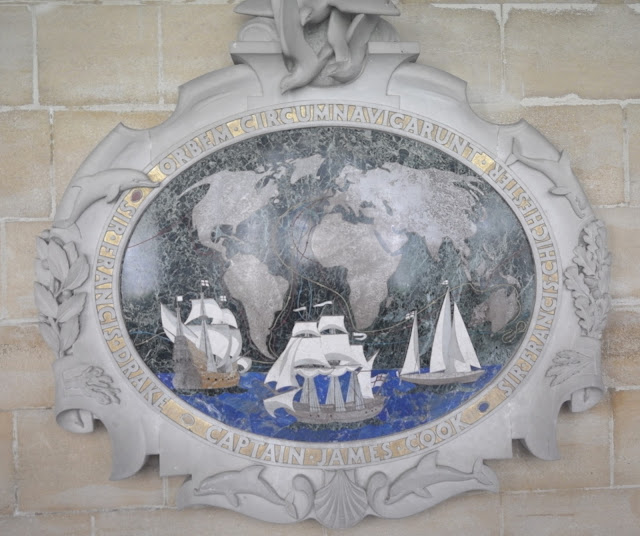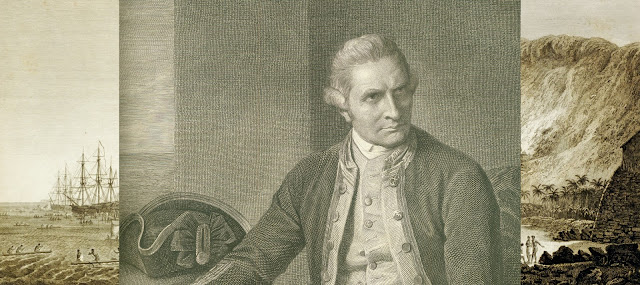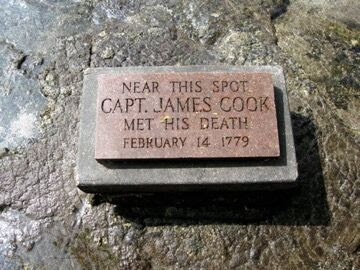 |
| Captain Cook Memorial Westminster Abbey, London, UK |
Was Britain’s Captain Cook (1728 -1779) an explorer or an invader? The intrepid captain from Yorkshire circumnavigated the globe, cruised all around the vast Pacific ocean and was an extraordinary navigator. Cook left his mark on geography and on the world.
 |
| Cook Plaque London, UK |
Cook lived for many years in the East end of London though, sadly, his home no longer exists. Near the site of his home is a green grocer. A plaque marks the spot where his home was.
In the Alaska chapter of America Invaded: A State by State Guide to Fighting on American Soil (www.americainvaded.com) we noted…
“In June of 1778, Captain James Cook of the HMS Resolution sailed into the inlet that now bears his name. He explored Alaskan waters, searching in vain for a northwest passage. In his Journals, Cook wrote that “several of the Natives paid us a visit, and brought with them a few skins some pieces of Salmon and Holibut which they exchanged with our people for old cloaths or whatever they could get” (sic). Cook traded with the wary natives, but did not really fight them. He also discovered evidence of Russian contact with the native tribes.”
 |
| Captain Cook 1728 – 1779 |
And in the Hawaii chapter we observed…
“In 1778, with the arrival of Captain Cook at Waimea Bay on the island of Kauai, two warrior cultures collided in mutual misunderstanding. Captain Cook of Britain’s Royal Navy was on his third voyage of exploration. His preferred technique for dealing with native populations was a combination of bluff, hostage taking, and firepower.
In his Journals, Cook explicitly described how his exploration method could be construed or misconstrued as an invasion:
We attempt to land in a peaceable manner, if this succeeds its well, if not we land nevertheless and maintain the footing we thus got by the Superiority of our fire arms, in what other light can they than at first look upon us but as invaders of their Country; time and some acquaintance with us can only convince them of their mistake.
At first the Hawaiians regarded Cook with reverence. Many prostrated themselves at his feet, and some may have taken him for the god Lono. Some of the women were eager to trade sex for nails. His two ships were restocked with fresh water, fruits, and vegetables. Cook christened Hawaii the Sandwich Islands in honor of his patron, the Earl of Sandwich.
 |
| Cook Monument Hawaii |
Cook departed the islands to voyage north to Alaska, but returned to Kealakekua on the Big Island in February of 1779. His ship, the Resolution, had a broken mast that needed repairing. Cook described the native Hawaiians in glowing terms: “These people trade with the least suspicion of any Indians I ever met … It is also remarkable that they have never once attempted to cheat us in exchanges or once to commit a theft.”
 |
| Captain Cook Plaque Hawaii |
The death of Cook on February 14, 1779, in Hawaii remains something of a mystery to this day. His crew had earlier taken some sacred wooden palings from the Hawaiians for use as firewood. This distressed the native people. Cook’s attempt to seize a local priest misfired badly. A mob of Hawaiians gathered. Cook fired his two pistols. He was stabbed with an iron dagger, which must have been procured or stolen from one of his ships. Four royal marines were also killed in the skirmish. Cook’s body was seized by the Hawaiians, mutilated, and partially devoured. Today, a white obelisk commemorates the spot near where Cook fell.”
Was Cook an explorer or an invader? Clearly he was both. In the Introduction to America Invaded: A State by State Guide to Fighting on American Soil we write, “The boundary between exploration and invasion can be a fine line determined largely by one’s perspective.” Cook saw himself as an explorer and a captain of the Royal Navy. The native Hawaiians, however, ultimately saw him as an invader.
Travel Notes: The plaque marking Cook’s home can be found today in London’s East end near Whitechapel. The Cook Monument on the Big Island of Hawaii is NOT accessible by car. I remember a taking a beautiful hike down to the beach where the monument can be found. The only other way to get there is to take a boat to it. Well worth the visit if you can make it!

